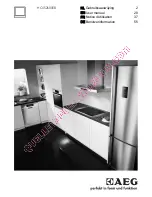
5 ENGLISH
Installing or removing drill bit
CAUTION:
Always be sure that the tool is
switched off and unplugged before installing or
removing the drill bit.
For model M8103
►
Fig.5:
1.
Drill chuck
2.
Chuck key
To install the drill bit, place it in the drill chuck as far as
it will go. Tighten the chuck by hand. Place the chuck
key in each of the three holes and tighten clockwise. Be
sure to tighten all three chuck holes evenly.
To remove the drill bit, turn the drill chuck key counter
-
clockwise in just one hole, then loosen the chuck by
hand.
After using the chuck key, be sure to return it to the
original position.
For Model M8104
►
Fig.6:
1.
Sleeve
2.
Ring
Hold the ring and turn the sleeve counterclockwise to
open the chuck jaws. Place the drill bit in the drill chuck
as far as it will go. Hold the ring firmly and turn the
sleeve clockwise to tighten the chuck.
To remove the drill bit, hold the ring and turn the sleeve
counterclockwise.
Depth gauge
Optional accessory
►
Fig.7:
1.
Side grip
2.
Depth gauge
3.
Grip base
4.
Hex bolt
The depth gauge is convenient for drilling holes of
uniform depth. Install the depth gauge by the following
sequence.
1.
Turn the side grip counterclockwise to loosen the
hex bolt.
2.
Insert the depth gauge and adjust the depth of
hole.
3.
Turn the side grip clockwise so that the depth
gauge and the grip base are fixed on the tool
completely.
NOTE:
The depth gauge cannot be used at the posi
-
tion where the depth gauge strikes against the tool
body.
OPERATION
CAUTION:
Always use the side grip (auxiliary
handle) and firmly hold the tool by both side grip
and switch handle during operations.
►
Fig.8
Hammer drilling operation
CAUTION:
There is tremendous and sudden
twisting force exerted on the tool/drill bit at the time of
hole break-through, when the hole becomes clogged
with chips and particles, or when striking reinforcing
rods embedded in the concrete.
Always use the side
grip (auxiliary handle) and firmly hold the tool by
both side grip and switch handle during opera-
tions.
Failure to do so may result in the loss of control
of the tool and potentially severe injury.
When drilling in concrete, granite, tile, etc., slide the
action mode changing lever to the position of symbol
to use "rotation with hammering" action. Be sure to use
a tungsten-carbide tipped drill bit. Do not apply more
pressure when the hole becomes clogged with chips or
particles. Instead, run the tool at an idle, then remove
the drill bit partially from the hole. By repeating this
several times, the hole will be cleaned out.
After drilling the hole, use the blow-out bulb to clean the
dust out of the hole.
Drilling operation
CAUTION:
Pressing excessively on the tool
will not speed up the drilling.
In fact, this excessive
pressure will only serve to damage the tip of your drill
bit, decrease the tool performance and shorten the
service life of the tool.
CAUTION:
Hold the tool firmly and exert care
when the drill bit begins to break through the
workpiece.
There is a tremendous force exerted on
the tool/drill bit at the time of hole break through.
CAUTION:
A stuck drill bit can be removed
simply by setting the reversing switch to reverse
rotation in order to back out. However, the tool
may back out abruptly if you do not hold it firmly.
CAUTION:
Always secure small workpieces
in a vise or similar hold-down device.
When drilling in wood, metal or plastic materials,
slide the action mode changing lever to the position
of
symbol to use "rotation only" action.
Drilling in wood
When drilling in wood, the best results are obtained
with wood drills equipped with a guide screw. The guide
screw makes drilling easier by pulling the drill bit into
the workpiece.
Drilling in metal
To prevent the drill bit from slipping when starting a
hole, make an indentation with a center-punch and
hammer at the point to be drilled. Place the point of the
drill bit in the indentation and start drilling.
Use a cutting lubricant when drilling metals. The excep
-
tions are iron and brass which should be drilled dry.






































